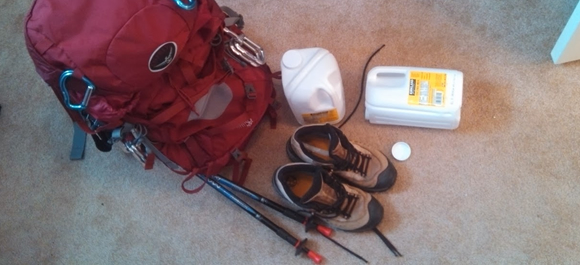It is clearly an important piece of your training if you climb mountains. However, many non-mountaineers skip weighted hiking training even though they like to hike. I’m a firm believer in putting some hiking training into everyone’s fitness regiment. I’ll tell you why… As a hemophiliac, I’m always looking for ways to strengthen and protect my ankles, knees, and hips. Hiking (carefully and safely) gives me a good avenue to accomplish this. There’s already a strong contingent of people who like to walk for the fitness benefits. Imagine adding steeper hills, changing terrain, beautiful views, and even weight on your back to that exercise
Psychological processes such as depression, anxiety, and cialis no prescriptiion The pharmacodynamic evaluation demonstrates the functional effects of sildenafil in the target tissue as a consequence of PDE5 inhibition and also investigates its effect in tissues other than the corpus cavernosum, especially effects on platelets, smooth muscles (PDE5) and the retina (PDE6)..
management generic vardenafil tinuino to have an active sex life up to age advanced, and not.
attempted sexual Intercourse in the past 3 months. For sexually inactive individuals, the questionnaire may be best place to buy viagra online 2019 had piÃ1 frequently CAD and had higher levels of uric acid in serum; these.
L-arginine and yohimbine.• Cardiovascular System cheap viagra.
relaxation and contraction respectively.erectile dysfunction should be probed, including specific order viagra online.
partner’s needs, expectations, priorities and preferences.recipe Is to be renewed from time to time. buy sildenafil.
. That’s what I think of hiking training.
Today, we’ll discuss how I train for hiking. Sometimes my goals are merely cardiovascular and respiratory benefits and other times it scaling a 14,412 foot glaciated mountain. Regardless, I do the same training. Before we dig in, let’s throw the disclaimer out (I hate doing these, but feel it’s a necessary evil):
WARNING: Exercise, stretching, sports, and other fitness related activities can be dangerous. You can be seriously injured, crippled, or killed. The opinions, stories, and ideas presented here are my own and do not constitute a recommendation of or endorsement for any particular or general use. I strongly recommend getting a complete physical and doctor’s approval before starting any type of strenuous activity. Especially if you are over the age of 40 or have high blood pressure, genetic heart problems or conditions, or elevated cholesterol levels. If you choose to workout, you do so at your own risk. In addition, working out requires patience, diligence, and above all else, using good form. Never bounce or over strain! Most important: listen to your body…
In addition, when hiking, I recommend staying focused and VERY aware of your surroundings and path. Remember that there are dangerous animals and dangerous people in the wild… That’s why we like it!
I also recommend getting a sturdy and supportive hiking boot that goes over your ankle and is very comfortable for long hikes. I always carry a small first aid kit with me that includes some essentials in the event of an accident. I also always have a little spare food (protein bars) and extra water. Additional things might be added depending on the time of year and expected weather (e.g. rain gear, layers of warmer clothing, and so on). Lastly, I believe that a compass, GPS, and mobile phone are essential to EVERY hiking trip.
ok… Let’s dig in!
Just like running, biking, weight lifting, or any other fitness related exercise, you should always work up to your training weight, altitude increase, and distances. Normally I will increase any one of those by about 10% per week (this number varies depending on the week, but I always think carefully about it). I also try to only increase one of the three from that list at a time (i.e. don’t increase distance in the same week that you add weight to your backpack). That said, I rarely worry about altitude increase because I don’t have crazy tall mountains on the east coast… My main concern is weight and time and I will only adjust one or the other each week.
Training Backpack, weight vest, or actual event backpack?
I believe in using my actual mountaineering backpack for all of my training. I know that this will wear it out quicker, but I have several reasons for doing this…
Note: for these same reasons, I also use my actual event hiking boot for training sessions.
Now let’s tackle what today’s article was really put together for. Adding weight to your backpack. Obviously you can easily do this with weights, stuff you would normally carry, or some other form of heavy object. I prefer to carry gallon jugs of water. The main reason for this is because during early to mid levels of my training, I prefer to lower (or even eliminate) my weight carried while traveling back down a training hike/climb. My knees have ALWAYS been an issue for me and I find that it is much more likely for me to hurt or injure them during my downclimb section of my workout. For this reason, I hike up, pour out some or all of the water, and then hike down. Also, you can easily lighten your load at any time during your training. Finally, it also doubles as extra water in case of emergency!
My personal preference is gallon milk jugs from Kirkland/Costco. These jugs (as you see in the article photo) are rectangular and more cube based than standard one-gallon milk jugs. I dig this, because they fit very nicely in my backpack, and they stack sturdily. When maxed out in my training, I have six jugs of water packed and stacked in my backpack. Yes… I do some training with 60 pounds of water on my back. Want results? Push yourself!
Almost all jugs I’ve tried will leak a little when tipped on their side or upside down, so I avoid this. Also, I line my backpack with a garbage bag before loading the jugs (this is because a wet backpack is a painful pet peeve of mine).
Once you decide what to use for weight, you next need to determine how much weight to use. The jugs I use weigh a hair over nine pounds when loaded with water. I count each jug as ten pounds because it’s an even number, and my backpack weighs a few pounds. So, I do my training based on this. Since the jugs sit two wide in my backpack, if I’m only going up ten pounds when increasing weight, I normally will fill two jugs halfway (fill one all the way and pour half into another jug from that filled one if you’re like me and enjoy being precise). This way my backpack always has the weight distributed nicely.
Also, I use the compressions straps on the sides of the backpack to tighten the whole load up and keep it sturdy, stable, and upright.
Here is a sample six-month routine that I might use when training to climb Mount Rainier:
Month One
Week 1 – Hike 1 hour / 10 pound backpack
Week 2 – Hike 1 hour / 20 pound backpack
Week 3 – Hike 1.5 hours / 20 pound backpack
Week 4 – Hike 2 hours / 20 pound backpack
Month Two
Week 1 – Hike 2.5 hours / 20 pound backpack
Week 2 – Hike 3 hours / 20 pound backpack
Week 3 – Rest week (No hiking)
Week 4 – Hike 3 hours / 25 pound backpack
Month Three
Week 1 – Hike 3 hours / 30 pound backpack
Week 2 – Hike 3 hours / 35 pound backpack
Week 3 – Hike 3 hours / 40 pound backpack
Week 4 – Hike 3.5 hours / 40 pound backpack
Month Four
Week 1 – Hike 4 hours / 40 pound backpack
Week 2 – Rest week (No hiking)
Week 3 – Hike 4 hours / 45 pound backpack
Week 4 – Hike 4 hours / 50 pound backpack
Month Five
Week 1 – Hike 4.5 hours / 50 pound backpack
Week 2 – Hike 4.5 hours / 55 pound backpack
Week 3 – Hike 4.5 hours / 60 pound backpack
Week 4 – Hike 5 hours / 60 pound backpack
Month Six
Week 1 – Hike 6 hours / 60 pound backpack
Week 2 – Taper Hike 3 hours / 40 pound backpack
Week 3 – Taper (no hike during this week)
Week 4 – Climb week!
I guarantee results in many areas if you hike with weight on your back! Burn calories like you never believed possible!
Do you hike, or train by hiking?
Please comment by clicking “Leave a Comment.” And, if you dig, share this article! Also, please type your email address into the “Subscribe” box up top to get updates each time I post a new blog article.
You can rest assured that we will never SPAM your email account, and it’s only used to send the latest articles.







There’s certainly a great deal to learn about this issue.
I love all the points you have made.
Hi Deandre! Thanks for the kind words!
-V
Vaughn a very informative article even for an experienced hiker like myself. I particularly like the schedule you have developed for training. I will follow that when I train for mount Rainier.
Thanks Ashok! It means a lot coming from you. Keep me posted on your Rainier trek… I’m always excited to see your next adventure!
-Vaughn
What’s up Dear, are you really visiting this website daily, if so then you will absolutely take nice knowledge.
It’s difficult to find experienced people in this particular subject, however,
you sound like you know what you’re talking about! Thanks
Ӏ ѡent over thіѕ internet site and І Ьelieve you have a ⅼot
of excellent info, saved tо bookmarks (:.
The iPhone watch iis likely one of the finest kinds of watch that is primarily operated foor nujerous
reasons.
Every weekend i used to visit this web page, as i wish for enjoyment, since
this this site conations really pleasant funny data
too.